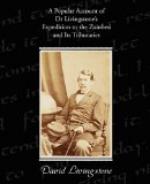The honey-guide is an extraordinary bird; how is it that every member of its family has learned that all men, white or black, are fond of honey? The instant the little fellow gets a glimpse of a man, he hastens to greet him with the hearty invitation to come, as Mbia translated it, to a bees’ hive, and take some honey. He flies on in the proper direction, perches on a tree, and looks back to see if you are following; then on to another and another, until he guides you to the spot. If you do not accept his first invitation he follows you with pressing importunities, quite as anxious to lure the stranger to the bees’ hive as other birds are to draw him away from their own nest. Except while on the march, our men were sure to accept the invitation, and manifested the same by a peculiar responsive whistle, meaning, as they said, “All right, go ahead; we are coming.” The bird never deceived them, but always guided them to a hive of bees, though some had but little honey in store. Has this peculiar habit of the honey-guide its origin, as the attachment of dogs, in friendship for man, or in love for the sweet pickings of the plunder left on the ground? Self-interest aiding in preservation from danger seems to be the rule in most cases, as, for instance, in the bird that guards the buffalo and rhinoceros. The grass is often so tall and dense that one could go close up to these animals quite unperceived; but the guardian bird, sitting on the beast, sees the approach of danger, flaps its wings and screams, which causes its bulky charge to rush off from a foe he has neither seen nor heard; for his reward the vigilant little watcher has the pick of the parasites on his fat friend. In other cases a chance of escape must be given even by the animal itself to its prey; as in the rattle-snake, which, when excited to strike, cannot avoid using his rattle, any more than the cat can resist curling its tail when excited in the chase of a mouse, or the cobra can refrain from inflating the loose skin of the neck and extending it laterally, before striking its poison fangs into its victim. There are many snakes in parts of this pass; they basked in the warm sunshine, but rustled off through the leaves as we approached. We observed one morning a small one of a deadly poisonous species, named Kakone, on a bush by the wayside, quietly resting in a horizontal position, digesting a lizard for breakfast. Though openly in view, its colours and curves so closely resembled a small branch that some failed to see it, even after being asked if they perceived anything on the bush. Here also one of our number had a glance at another species, rarely seen, and whose swift lightning-like motion has given rise to the native proverb, that when a man sees this snake he will forthwith become a rich man.




